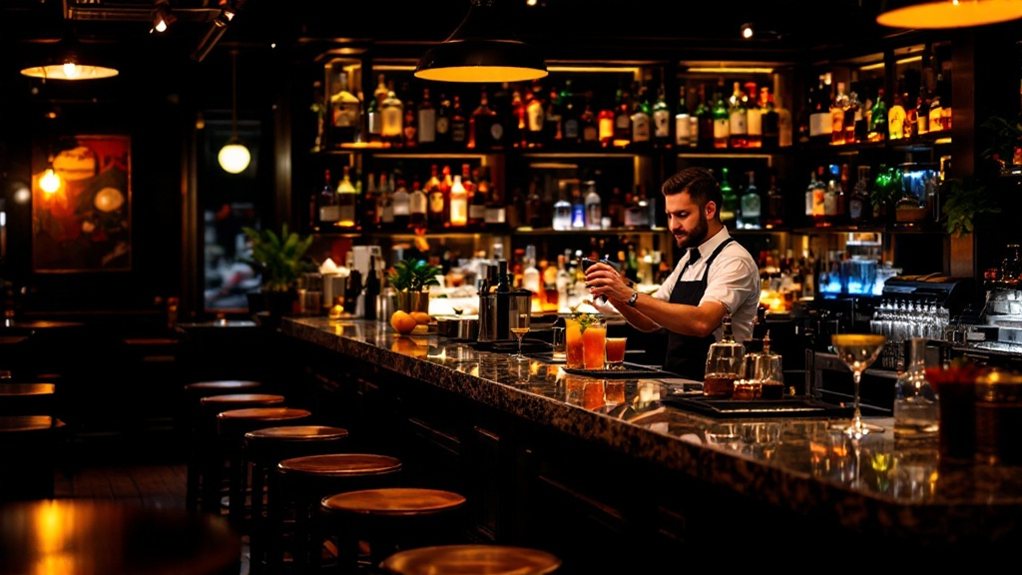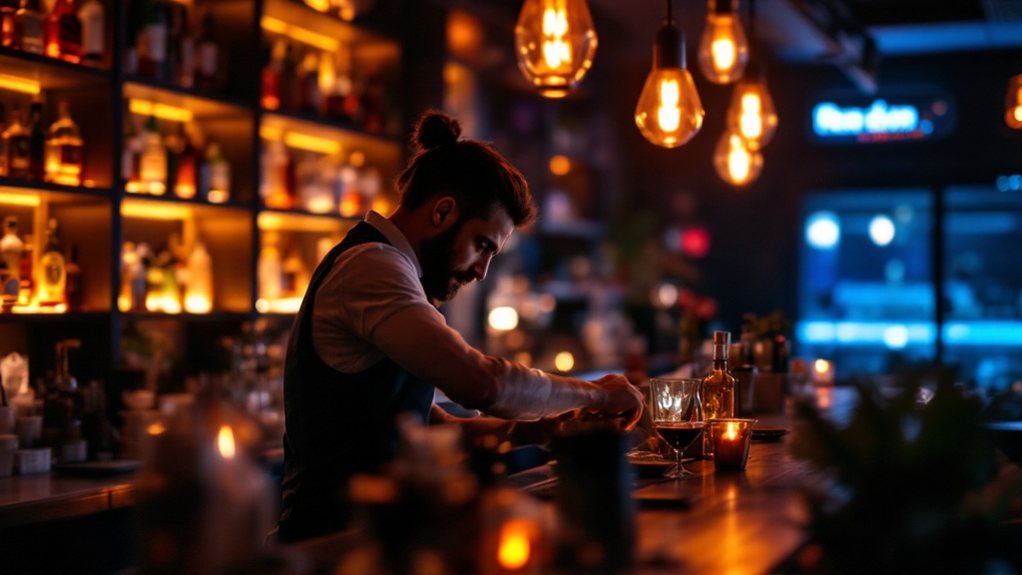Capitalize on hyper-local trends to optimize your bar's local SEO. Embrace the moderation movement by offering creative mocktails and low-ABV experiences. Elevate your bar's premiumization by prioritizing wellness and memorable experiences. Align your bar's offerings with culinary trends, adapt to seasonal changes, and prioritize mobile-first indexing. Harness hyper-local targeting and leverage AI to ensure accurate local listing optimization. Keep reading to dive deeper into effective local SEO strategies for your bar business.
Capitalizing on Hyper-localization in the Bar Industry

Often, bars that embrace hyper-localization strategies can capitalize on the growing consumer demand for unique, sustainable experiences. By sourcing ingredients and products from nearby suppliers, you can reduce your carbon footprint while fostering community engagement. Customers increasingly perceive locally sourced offerings as more authentic, and bespoke collaborations with local distillers can enhance the customer experience. However, overcoming logistical challenges with local suppliers can be tricky. Leveraging digital technologies like QR code menus and mobile ordering apps can streamline operations and appeal to tech-savvy patrons. Ultimately, hyper-localization allows you to differentiate your bar, promote sustainability, and build lasting connections with your community.
Embracing the Moderation Movement in Bars

As the moderation movement gains traction, bars can embrace this trend by offering low-alcohol cocktail options, promoting mindful drinking practices, and providing healthier bar experiences. The no/low alcohol market surpassed $11 billion by 2022 and continues to expand Tapping into the growing demand for non-alcoholic beverages can attract a new demographic of wellness-conscious customers. By catering to this movement, bars can differentiate themselves and capitalize on a lucrative market opportunity.
Low-Alcohol Cocktail Offerings
The growing demand for low-alcohol cocktails has become a prominent trend in the bar industry, as consumers, particularly Millennials and Gen Z, increasingly seek out healthier and more moderate drinking options. To cater to this shift, bars are offering creative mocktails and value-driven low-ABV experiences, like Aperitivo Hours. Additionally, the incorporation of botanical ingredients, spices, and functional add-ins, such as CBD and adaptogens, is driving innovation in low-alcohol recipes. Health and wellbeing top spending priority after living essentials has contributed to the rise in low-alcohol cocktail offerings.
| Emerging Trends | Key Ingredients | Consumer Behavior |
|---|---|---|
| Minimalist cocktails | Botanicals | Health and wellness focus |
| Spritz cocktails | Spices and seeds | Value for money |
| Flavored beverages | Tea bases | Social media influence |
| Seasonal ingredients | Superfoods and supplements | Sober-curious mindset |
Mindful Drinking Practices
The growing consumer interest in low-alcohol cocktails has paved the way for the rise of mindful drinking practices in the bar industry. Mindful drinkers seek quality over quantity, exploring non-alcoholic alternatives to promote improved well-being. This approach encourages individuals to monitor their reasons for drinking and its effects on their bodies. Sober curiosity, closely related to mindful drinking, has gained traction through social media and cultural events. Bars and restaurants are now introducing more non-alcoholic options to cater to this health-conscious audience. This shift supports a broader cultural attitude toward moderation, fostering a supportive community that embraces inclusive and balanced lifestyle choices. [Mindful drinking aims to maximize enjoyment and minimize negative side effects.
Healthier Bar Experiences
Although the moderation movement in bars may seem like a recent phenomenon, it reflects a broader cultural shift towards health and wellness, leading to increased demand for low- and no-alcohol options. Bars are now offering a variety of sophisticated no- or low-alcohol drinks, elevating their menus with premium non-alcoholic spirits and craft techniques. Millennials and Gen Z, prioritizing wellness and mental clarity, are driving this trend, as social dynamics evolve with alcohol no longer a default choice. Over 40% of Gen Z have never tried alcohol, a fact that highlights the growing appeal of moderation. By optimizing their websites and listings for local SEO, highlighting unique selling points like non-alcoholic offerings, bars can differentiate themselves and attract health-conscious consumers, positioning themselves for long-term success in the moderation movement.
Elevating the Premiumization Evolution for Bars

As the premium cocktail landscape evolves, bars must elevate their offerings to captivate discerning consumers. Younger generations like Gen Z seek unique flavors and educational experiences, fueling the rise of bartenders as drink storytellers. To stay ahead, bars should focus on craftsmanship and memorable experiences, not just product quality. Non-alcoholic beverage volume grew 20% in 2023, indicating the importance of diversifying the menu to cater to this growing segment. Consider integrating a table showcasing key trends:
| Trend | Impact |
|---|---|
| Affordable Luxury | Consumers prioritize experiences over price, favoring $17-49.99 cocktails. |
| Mobile Search | Optimizing for local SEO and mobile-friendly sites is crucial to attract nearby patrons. |
| Positive Reviews | Stellar customer feedback boosts local visibility and brand reputation. |
Aligning Bar Offerings With Culinary Trends
Bars must pair cocktails with complementary cuisine to elevate the overall dining experience. Leveraging local food trends can help bars create unique, region-specific offerings that resonate with customers. Delivering holistic dining experiences that seamlessly blend mixology and gastronomy is key to staying ahead of the curve. By aligning bar offerings with popular culinary trends, bars can attract new customers and increase revenue.
Pairing Cocktails With Cuisine
Elevating the dining experience, the trend of pairing cocktails with cuisine has taken the culinary world by storm. Mixologists are getting more creative, offering three main pairing strategies: complementing, contrasting, and highlighting flavors. Understand flavor profiles to achieve a successful match Cocktails can enhance specific tastes in a dish, and cultural influences play a significant role. Complementary pairings match similar profiles, while contrasting combines sweet and spicy. Highlighting makes a flavor stand out without overpowering others. Seasonal and regional elements also shape pairings. Innovative concepts, like luxurious cocktails with casual food, showcase this evolving trend. Effective local SEO helps bars and restaurants showcase their unique pairing offerings, drawing in new customers through online visibility and reviews.
Leveraging Local Food Trends
Local culinary trends present an opportunity for bars to align their offerings and enhance the overall dining experience. Embrace sustainability by sourcing local ingredients, reducing waste, and adopting energy-efficient practices. Cater to wellness-conscious patrons with beverages featuring probiotics and umami-rich cocktails. Experiment with bold flavor combinations and global influences like Southeast Asian cuisines to excite adventurous diners. Provide value through quality ingredients, unique ambiance, and personalized touches. Optimize your local online presence to attract nearby customers searching for dining experiences that align with their evolving preferences.
Delivering Holistic Dining Experiences
As the culinary landscape evolves, bars must adapt their offerings to align with emerging trends and deliver a truly holistic dining experience. Consumers seek healthful options and clear nutritional information, so bars should integrate more sustainable, locally-sourced ingredients. Consumers looking for clear indicators of healthy items on menus Leveraging digital technology, like contactless payments and mobile-friendly websites, enhances the overall guest experience. Unique dining events and experiences, such as chef's tables and cooking classes, attract new clientele. To stay competitive, bars must be agile in responding to changing preferences, prioritizing both taste and nutrition. By aligning their bar offerings with broader culinary trends, establishments can provide a cohesive, memorable dining journey for their patrons.
Adapting to Seasonal Menu Changes in Bars
Adapting your bar's menu to seasonal changes can be a strategic move that resonates with your patrons. By aligning your offerings with local tastes and ingredient availability, you can enhance the dining experience and boost profitability. Seasonal menus allow you to manage costs effectively, as you can leverage fresh, in-season ingredients. Consumers perceive seasonal dishes as more flavorful and healthier, and 42% are willing to pay more for them. Optimizing your website and local listings with seasonal keywords can increase visibility and drive more traffic to your establishment. Embracing the challenges and opportunities of seasonal menus can set your bar apart, fostering customer loyalty and culinary innovation.
Optimizing Local SEO for Voice Search
The rise of voice search has significantly impacted local SEO, presenting both challenges and opportunities for businesses. To optimize for voice search, you must:
- Craft content with conversational language and long-tail keywords that mirror natural speech.
- Ensure your website is mobile-friendly, as most voice searches originate from smartphones.
- Leverage structured data and maintain accurate Google Business profiles to enhance visibility in local search results.
Prioritizing Mobile-First Indexing for Local Businesses
As a local business, you can't ignore the impact of mobile-first indexing. Ensure your website has a responsive design that provides a seamless experience across devices. Prioritize streamlined mobile navigation and quick-loading pages to boost your rankings and reach more customers on the go.
Responsive Website Design
With Google's shift towards mobile-first indexing, you must prioritize responsive website design for your local business. A mobile-optimized site is crucial for maintaining or improving your search engine rankings. Here are three key considerations for responsive design:
- Ensure your website seamlessly adapts to different screen sizes, providing a consistent user experience across devices.
- Optimize page loading speeds to enhance customer satisfaction and search engine performance.
- Incorporate mobile-specific features that cater to the unique needs and behaviors of your local customers.
Responsive design is essential for aligning your online presence with the growing preference for mobile access to local information.
Streamlined Mobile Navigation
Streamlining your mobile navigation is crucial as Google's mobile-first indexing becomes the norm for local businesses. By simplifying your menu, prioritizing essential items, and optimizing images, you can create a responsive and user-friendly experience. Incorporate gesture-based interactions, contextual gestures, and intuitive affordances to enhance navigation further. Leverage effective patterns like bottom bars, card-based systems, and collapsible menus to organize your content. Optimize for local SEO by including location-specific features, managing Google My Business, and utilizing structured data and conversational keywords. Monitor your performance through A/B testing, analytics, and user feedback to continuously refine your mobile navigation strategy.
| Navigation Basics | Swipe and Gesture | Patterns |
|---|---|---|
| Simplified Menu | Gesture-Based | Bottom Bar |
| Essential Items | Contextual Gestures | Card-Based |
| Quick Response | Reduced Buttons | Full-Screen |
| Optimized Images | Smooth Transitions | Tab Systems |
| Feedback Mechanisms | Intuitive Affordances | Collapsible Menus |
Google's Mobile-First Indexing
Google's mobile-first indexing has become a critical priority for local businesses in today's digital landscape. With over half of global web traffic coming from mobile devices, having a mobile-optimized website is essential for visibility and success. Here are three key considerations for local businesses when it comes to mobile-first indexing:
- Responsive Design: Ensure your website seamlessly adapts to various screen sizes and devices, providing a consistent and user-friendly experience.
- Local Search Optimization: Optimize your content and listings for local search queries to improve your prominence in Google's Map Pack.
- Mobile Performance Metrics: Closely monitor your website's mobile performance, such as loading speed and engagement, to identify and address any issues.
Harnessing Hyper-local Targeting in Local SEO
Harnessing the power of hyperlocal targeting is essential for small businesses looking to dominate their local markets. By optimizing your Google Business Profile with accurate details and encouraging reviews, you can improve your visibility. Leverage geo-specific keywords and create localized content that resonates with your immediate community. Ensure consistent local citations across directories to boost credibility. Analyze search patterns in your neighborhood and tailor your strategies accordingly. From incorporating schema markup to leveraging voice and mobile searches, a comprehensive hyperlocal SEO approach will help you outrank competitors and connect with your target audience. Stay agile, monitor performance, and make data-driven adjustments to your hyperlocal tactics.
Leveraging AI and Machine Learning in Local SEO
As businesses aim to dominate their local markets, harnessing the power of artificial intelligence (AI) and machine learning has become a game-changer in local SEO. AI-powered tools can:
- Uncover valuable, localized keywords and search trends, helping you outshine competitors.
- Streamline content creation by generating hyper-personalized copy and automating translation, freeing up resources for strategic planning.
- Enhance review management, detecting fake reviews and analyzing sentiment to improve your online reputation.
Integrating AI into your local SEO strategy ensures you remain ahead of the curve, delivering exceptional user experiences and boosting your visibility in the hyper-competitive digital landscape.
Ensuring Accurate Local Listing Optimization
How can you ensure your local business listings are accurate and up-to-date? Maintaining consistent name, address, and phone number (NAP) across citations is crucial for credibility and verification. Optimize your Google Business Profile with comprehensive details to boost local visibility. Utilize tools to manage and maintain consistent listings across platforms. Regularly update business hours and contact info to support accurate search results. Verify all local listings to improve credibility and trust. Encourage customer reviews on key platforms, respond promptly, and analyze performance. Incorporate location-based keywords and leverage tools for local keyword research. List your business on general and niche-specific citation sites, local directories, and hyperlocal listings to enhance visibility.
